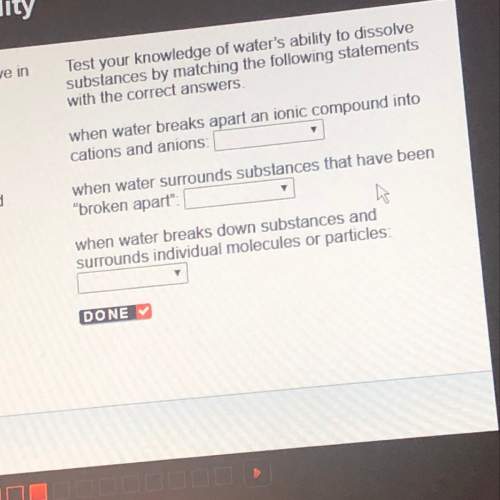
Chemistry, 25.01.2022 01:30 maariaaa10
1. Which form of energy changes in chemical reactions due to bonds breaking and forming? (1 point)
activation
potential
thermal
kinetic
2. What does it mean for a reaction to release energy? (1 point)
The relative potential energy of the reaction is positive.
The relative potential energy of the reaction is negative.
The activation energy of the reaction is positive.
The activation energy of the reaction is negative.
3. Heat is added to a chemical system. Which energy will increase? (1 point)
the relative potential energy of the system
the potential energy of the products
the activation energy of the system
the kinetic energy of the reactant molecules
4. Carbon monoxide and nitrogen monoxide react to produce carbon dioxide and nitrogen gas. If the system contains platinum, then less energy is required for the reaction to occur. Which term best describes the role of platinum in the system? (1 point)
reactant
energy
product
catalyst
5. The two oxygen atoms in a molecule of oxygen gas share their outer electrons. Which type of bond do the oxygen atoms form? (1 point)
ionic
exothermic
endothermic
covalent

Answers: 1
Another question on Chemistry

Chemistry, 22.06.2019 01:20
1. suppose a reaction mixture, when diluted with water, afforded 300 ml of an aqueous solution of 30 g of the reaction product malononitrile [ch2(cn)2], which is to be isolated by extraction with ether. the solubility of malononitrile in ether at room temperature is 20.0 g/100 ml, and in water is 13.3 g/100 ml. what weight of malononitrile would be recovered by extraction with (a) three 100-ml portions of ether and (b) one 300-ml portion of ether? suggestion: for each extraction, let x equal the weight extracted into the ether layer. in part (a), the concentration in the ether layer is x/100 and in the water layer is (30 x)/300; the ratio of these quantities is equal to k 20/13.3.
Answers: 2

Chemistry, 22.06.2019 09:00
What is the percentage composition of carbon in the compound ch4
Answers: 1

Chemistry, 22.06.2019 16:00
Is a measure of the resistance to flow. a high liquid has a high resistance to flow and flows slowly. the ancients thought everything in the world was made of 4 we now know that there are 94 naturally occurring and scientists have created another 24 i am certain they will create even more. honey flows slowly because it has a high to flowing. a can be separated by physical means because it contains more than one pure substance and 2 pure substances are not chemically bonded to each other. a cannot be separated by physical means. all matter is made up of all elements are with the same number of protons. if it is just a single or many bonded together, if all of them have the same number of protons, it is an element. in a piece of pure iron metal, all the are joined together, that piece of iron metal is called elemental iron. a single of iron is called elemental iron. a mixture has differences from place to place. we might need a microscope to see them or they might be obvious to the unaided eye. there are surfaces separating it into different phases. a mixture is the same everywhere. it is uniform. there are no surfaces separating it into different phases. if different kinds of atoms (different elements) are bonded together by their electrons, it is called a there are physical means of to isolate the different pure substances in a mixture and there are chemical means of to isolate the different elements in a compound. 1. element 2. compound 3. mixture 4. heterogeneous 5. homogeneous 6. pure substance 7. atoms 8. separation 9. viscosity 10. resistance
Answers: 2

Chemistry, 22.06.2019 23:30
Substance a is a nonpolar liquid and has only dispersion forces among its constituent particles. substance b is also a nonpolar liquid and has about the same magnitude of dispersion forces among its constituent particles. when substance a and b are combined, they spontaneously mix.
Answers: 1
You know the right answer?
1. Which form of energy changes in chemical reactions due to bonds breaking and forming? (1 point)...
Questions

Chemistry, 03.12.2021 01:30





Business, 03.12.2021 01:40

Business, 03.12.2021 01:40

Mathematics, 03.12.2021 01:40





Physics, 03.12.2021 01:40

English, 03.12.2021 01:40

History, 03.12.2021 01:40


Geography, 03.12.2021 01:40

Mathematics, 03.12.2021 01:40


History, 03.12.2021 01:40




